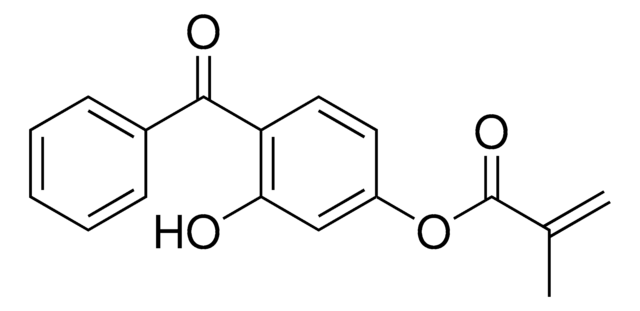413216
2-(4-Benzoyl-3-hydroxyphenoxy)ethyl acrylate
98%
동의어(들):
2-Hydroxy-4-acryloxyethoxybenzophenone, 4-(2-Acryloxyethoxy)-2-hydroxybenzophenone
로그인조직 및 계약 가격 보기
모든 사진(3)
About This Item
Linear Formula:
H2C=CHCO2CH2CH2OC6H3(OH)COC6H5
CAS Number:
Molecular Weight:
312.32
EC Number:
MDL number:
UNSPSC 코드:
12162002
PubChem Substance ID:
NACRES:
NA.23
추천 제품
일반 설명
2-(4-Benzoyl-3-hydroxyphenoxy)ethyl acrylate is a derivative of oxybenzone that is widely used as a UV-blocking agent in the fabrication of contact lenses. It contains both a vinyl group and an aromatic benzoyl group which makes it useful in polymerization and crosslinking reactions. This acrylate monomer is commonly used as a building block in the synthesis of polymers utilized in various coatings, adhesives, and dental fillings. Due to its unique structure, it can exhibit desirable properties such as high reactivity, good adhesion to a variety of substrates, and resistance to UV degradation.
애플리케이션
2-(4-Benzoyl-3-hydroxyphenoxy)ethylacrylate can be used as a monomer to synthesize fluorine-silicone acrylic resinto improve the UV resistance of the resin and make it more durable andlong-lasting.
Storage Class Code
11 - Combustible Solids
WGK
WGK 3
Flash Point (°F)
Not applicable
Flash Point (°C)
Not applicable
개인 보호 장비
Eyeshields, Gloves, type N95 (US)
이미 열람한 고객
T V Chirila et al.
Journal of cataract and refractive surgery, 15(5), 504-509 (1989-09-01)
A poly(2-hydroxyethyl methacrylate) hydrogel material exhibiting ultraviolet-absorbing properties was synthesized by simultaneous polymerization, crosslinking, and covalent bonding of an available polymerizable absorber. The two-stage leaching experiments carried out by aqueous extraction and the analysis of the concentrated extracts by high
T V Chirila et al.
Journal of cataract and refractive surgery, 17(5), 596-603 (1991-09-01)
A tendency to reduce the use of benzophenone absorbers is currently evident in the manufacture of the UV-absorbing IOLs, mainly because the cutoff wavelengths are inferior to those provided by benzotriazoles. In principle, by incorporating large amounts of benzophenones it
자사의 과학자팀은 생명 과학, 재료 과학, 화학 합성, 크로마토그래피, 분석 및 기타 많은 영역을 포함한 모든 과학 분야에 경험이 있습니다..
고객지원팀으로 연락바랍니다.
![2-[3-(2H-Benzotriazol-2-yl)-4-hydroxyphenyl]ethyl methacrylate 99%](/deepweb/assets/sigmaaldrich/product/structures/208/967/cf29567e-c125-41dc-b80a-66889fa1a679/640/cf29567e-c125-41dc-b80a-66889fa1a679.png)


![2,2′-Methylenebis[6-(2H-benzotriazol-2-yl)-4-(1,1,3,3-tetramethylbutyl)phenol] 99%](/deepweb/assets/sigmaaldrich/product/structures/236/824/ce89085c-b9e1-4ea0-8157-44b6f9466ed6/640/ce89085c-b9e1-4ea0-8157-44b6f9466ed6.png)






